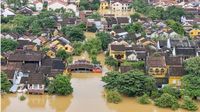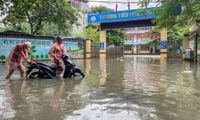Central Vietnam is reeling after a relentless onslaught of severe flooding and record-breaking rainfall left at least 40 people dead and six missing, with the threat of even more devastation looming as Typhoon Kalmaegi barrels toward the battered coastline. The past week has seen the region transformed by torrents of rain that, in some places, dumped up to 1.7 meters of water in just 24 hours—a figure that shattered national records and left local officials scrambling to respond, as reported by the Associated Press and AFP.
The disaster has been widespread and merciless. Torrential downpours began in late October 2025, triggering flash floods and landslides that inundated entire villages, swept away homes, and displaced tens of thousands of residents. According to Vietnam’s disaster management agency, fatalities have been recorded across Hue, Da Nang, Lam Dong, and Quang Tri provinces. The central city of Danang, a popular tourist destination, was among the many areas cut off from power and communications. In some neighborhoods, residents found themselves isolated by water or by landslides that blocked national highways and rural roads.
For many, the ordeal has been exhausting and deeply personal. “We are tired of floodings, but what can we do,” said Tran Thi Ky, a 57-year-old resident of Hoi An, to AFP. Her home, located in the UNESCO World Heritage-listed ancient town, was flooded three times in less than ten days. “We brought all our furniture to high ground but they are all wet anyway.”
The scale of the destruction is staggering. Nearly 80,000 houses remain flooded, and more than 10,000 hectares of crops have been destroyed. Over 68,000 cattle have perished in the deluge, according to official tallies cited by Channel NewsAsia. In Hue, the historic Imperial Citadel, known as the Dai Noi, suffered significant damage, with 15 meters of its ancient wall collapsing under the force of the floodwaters. Torrents have turned streets into canals and burst riverbanks, submerging even some of the country’s most visited historic sites.
Rescue operations have been hampered by the scale and persistence of the disaster. Although some relief arrived when water levels briefly receded late last week, rivers like the Huong and Bo in Hue City quickly began rising again as more rain fell. Many remote communities remain isolated, waiting for rescue teams to reach them as authorities work to clear debris and restore access. The government has mobilized efforts to distribute food, clean water, medicine, and shelter while helping families rebuild damaged homes and prevent disease outbreaks. Teams are also racing to restore power, water, and transportation links, repair irrigation systems, and support farmers in restarting crop and livestock production.
But the region’s ordeal is far from over. Typhoon Kalmaegi—a storm that has already killed at least five people and displaced hundreds of thousands in the Philippines, according to Vietnam’s National Centre for Hydro-Meteorological Forecasting—is forecast to make landfall in central Vietnam in the early hours of Friday, November 7, 2025. The typhoon could strike the coast with winds up to 166 kilometers per hour (103 mph) as early as Thursday, November 6. Vietnamese authorities are bracing for the worst, warning that the already saturated ground and swollen rivers could magnify the impact of the new storm.
Kalmaegi isn’t the first storm to hit Vietnam this year—far from it. In fact, it will be the 13th typhoon or tropical storm to affect the country in 2025, well above the usual annual average of ten. Earlier, Typhoons Ragasa, Bualoi, and Matmo battered various regions, leaving more than 85 people dead or missing in just two weeks and causing an estimated $1.36 billion in damage. According to the Associated Press, this relentless series of disasters has left little time for recovery between storms, compounding the hardship for millions of residents.
Vietnam’s vulnerability to flooding is not new. Nearly half of the nation’s population lives in high-risk flood areas, making it one of the most flood-prone countries in the world. The country’s central belt, stretching from Da Nang to Quang Tri, is especially susceptible to heavy rains between June and September each year—a period when rivers routinely swell and typhoons are most likely to strike.
What is changing, however, is the intensity and frequency of these extreme weather events. Scientists and meteorological agencies are sounding the alarm that human-driven climate change is making storms more destructive and rainfall more intense across Southeast Asia. According to Vietnam’s national weather bureau and multiple international agencies, there is clear scientific evidence linking global warming to the increasing severity of disasters like those currently unfolding in Vietnam. The pattern is unmistakable: warmer oceans and air hold more moisture, fueling heavier downpours and more powerful storms. As a result, floods that once might have been considered rare are now becoming all too common.
For residents and officials alike, the immediate priority is survival and recovery. Authorities are focused on rescuing those still stranded, providing for the displaced, and beginning the arduous process of rebuilding. Yet there is an undercurrent of anxiety about what the future holds. With the climate crisis intensifying, Vietnam’s experience this year may be a harbinger of even greater challenges to come.
International organizations and neighboring countries are watching closely, as the unfolding disaster in Vietnam echoes similar events across Southeast Asia. Typhoon Kalmaegi’s destructive path through the Philippines, where it killed at least five people and displaced hundreds of thousands, is a sobering reminder of the region’s interconnected vulnerability. The storm’s rapid intensification and unpredictable trajectory have made disaster preparedness and response even more difficult for local governments.
Despite the hardships, stories of resilience continue to emerge. Rescue teams have braved hazardous conditions to reach isolated communities, and neighbors have banded together to help one another move to higher ground and salvage what they can from the wreckage. Farmers, though devastated by the loss of crops and livestock, are already looking for ways to restart production with government support. The coming days will test this resilience even further as Typhoon Kalmaegi approaches, threatening to compound an already dire situation.
As central Vietnam braces for yet another storm, the country stands at a crossroads: caught between the immediate demands of disaster response and the long-term challenge of adapting to a changing climate. The events of this past week have laid bare the stakes—and the urgent need for solutions that can help communities weather the storms of the future.


